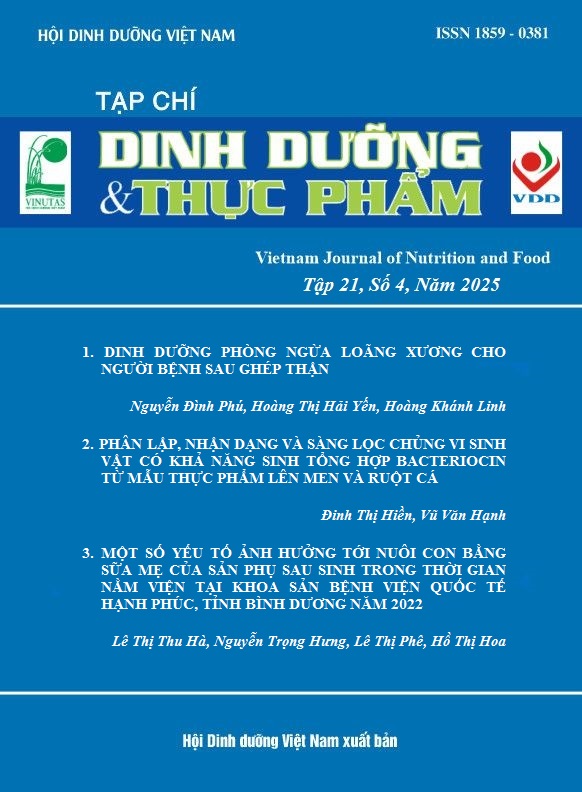SOME FACTORS ASSOCIATED WITH BREASTFEEDING AMONG POSTPARTUM MOTHERS DURING HOSPITALIZATION AT HANH PHUC INTERNATIONAL HOSPITAL, BINH DUONG PROVINCE, IN 2022
Main Article Content
Abstract
Aims: To identify factors associated with breastfeeding practices among postpartum mothers at Hanh Phuc International Hospital, Binh Duong Province.
Methods: A cross-sectional study was conducted combining quantitative and qualitative approaches. The quantitative component included observations using checklists and interviews with 270 postpartum mothers who had vaginal or cesarean deliveries. The qualitative component involved in-depth interviews and focus group discussions with healthcare staff and postpartum mothers.
Results: While 86.7% of newborns were breastfed within the first hour after birth, only 57.8% were exclusively breastfed during hospitalization. The main factors associated with breastfeeding practices included concerns about insufficient milk, blocked milk ducts, pain, and fatigue after childbirth, especially among mothers who underwent cesarean section. Some mothers prepared formula in advance for fear of an inadequate milk supply. Family support during breastfeeding was limited. Although the hospital promotes breastfeeding and discourages formula marketing, counseling services were inconsistent due to hospital overcrowding.
Conclusion: Despite a high rate of early initiation of breastfeeding, exclusive breastfeeding during hospital stay remains suboptimal, primarily due to maternal health and psychological factors. Enhanced postnatal counseling, antenatal education, and family involvement are needed to improve breastfeeding practices.
Keywords
Breastfeeding, postpartum mothers, influencing factors
Article Details
References
2. UNICEF, UNICEF Data. Monitoring the Situation of Children and Women. 2017. https://data.unicef.org.
3. Lâm Kim Hường. Tỷ lệ bú mẹ sớm sau sinh và nuôi con bằng sữa mẹ hoàn toàn tại thời điểm xuất viện và các yếu tố liên quan tại bệnh viện Phụ sản Thành phố Cần Thơ [Luận văn Thạc sĩ Y học]: Đại học Y Dược Thành phố Hồ Chí Minh; 2016.
4. WHO, UNICEF. second biennial progress report (2016–2017). 2018, https://iris.who.int/bitstream/handle/10665/272803/9789290618492-eng.pdf?sequence=1.
5. Ngô Thị Thanh Thảo, Trần Thị Hồng Thắm. Kiến thức, thái độ và thực hành cho bú mẹ sau sinh của các bà mẹ sinh ngã âm đạo tại Bệnh viện Hùng Vương, Thành phố Hồ Chí Minh. Tạp chí Phụ sản. 2019;16 (số 6):73-8.
6. Hoàng Thị Thu Hường. Thực trạng và một số yếu tố ảnh hưởng đến thực hiện quy trình chăm sóc thiết yếu bà mẹ, trẻ sơ sinh trong và ngay sau mổ lấy thai tại bệnh viện Vinmec năm 2018. Luận văn thạc sĩ Quản lý bệnh viện. Trường Đại học Y tế Công cộng, 2018.
7. Nguyễn Thị Hồng Hạnh. Khảo sát các yếu tố ảnh hưởng đến tỷ lệ cho con bú sữa mẹ hoàn toàn trong thời gian nằm viện tại Bệnh viện quốc tế Hạnh Phúc. Luận văn chuyên khoa cấp II. Trường Đại học Y khoa Phạm Ngọc Thạch, 2020.
8. Huỳnh Văn Tú. Thực trạng nuôi con bằng sữa mẹ trong thời gian nằm viện sau sinh tại Bệnh viện Phụ sản-Nhi bán công Bình Dương. Tạp chí Y học Thành phố Hồ Chí Minh. 2010;14(2):366-370.
9. Gao H, Wang Q, Hormann E, et al. Breastfeeding practices on postnatal wards in urban and rural areas of the Deyang region, Sichuan province of China. International breastfeeding journal. 2016;11(1):11.
10. Greer FR, Sicherer SH, Burks AW. The effects of early nutritional interventions on the development of atopic disease in infants and children: the role of maternal dietary restriction, breastfeeding, hydrolyzed formulas, and timing of introduction of allergenic complementary foods. Pediatrics. 2019;143(4).
11. Lou Z, Zeng G, Huang L, Wang Y, Zhou L, Kavanagh KF. Maternal reported indicators and causes of insufficient milk supply. Journal of Human Lactation. 2014;30(4):466-473.
12. Đinh Thị Hải Yến. Những yếu tố ảnh hưởng đến hành vi nuôi con bằng sữa mẹ hoàn toàn trong 6 tháng đầu tại huyện Củ Chi. Trung tâm Truyền thông giáo dục sức khỏe TP.HCM, 2014.
13. Lưu Ngọc Hoạt, Lê Thị Hương, Lê Thị Thanh Xuân và cs. Kiến thức và thực hành nuôi con bằng sữa mẹ của các bà mẹ Hà Nội năm 2010 - Các rào cản và yếu tố thúc đẩy. Tạp chí Y học Thực hành. 2010;6(723):43-47.
14. Agunbiade OM, Ogunleye OV. Constraints to exclusive breastfeeding practice among breastfeeding mothers in Southwest Nigeria: implications for scaling up. International breastfeeding journal. 2012;7(1):5.
15. Mannion CA, Hobbs AJ, McDonald SW, Tough SC. Maternal perceptions of partner support during breastfeeding. International breastfeeding journal. 2013;8(1):4.
16. Nguyễn Thị Thanh Huyền, Bùi Thị Huế, Vũ Thị Minh Phượng và cs. Thực trạng kiến thức nuôi con bằng sữa mẹ của các thai phụ đến khám tại bệnh viện phụ sản tỉnh Nam Định năm 2020. Tạp chí Khoa học Điều dưỡng. 2020;35(3):272-280.
17. Tuan NT, Nguyen PH, Hajeebhoy N, Frongillo EA. Gaps between breastfeeding awareness and practices in Vietnamese mothers result from inadequate support in health facilities and social norms. The Journal of Nutrition. 2014;144(11):1811-1817.


